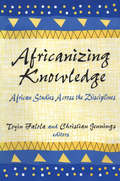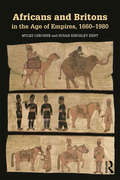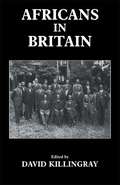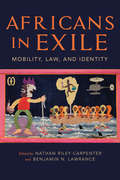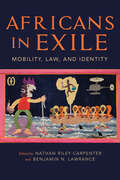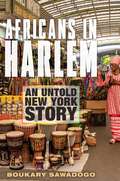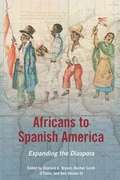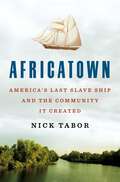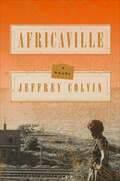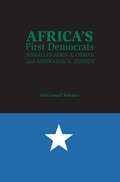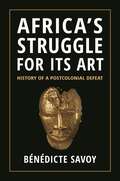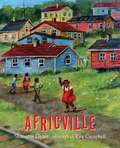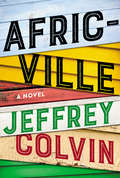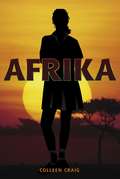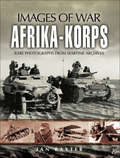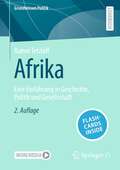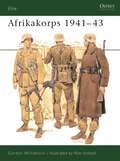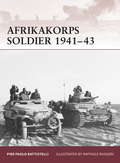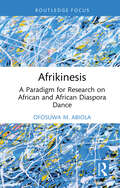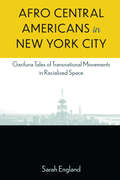- Table View
- List View
Africanizing Knowledge: African Studies Across the Disciplines
by Toyin FalolaNearly four decades ago, Terence Ranger questioned to what extent African history was actually African, and whether methods and concerns derived from Western historiography were really sufficient tools for researching and narrating African history. Despite a blossoming and branching out of Africanist scholarship in the last twenty years, that question is still haunting. The most prestigious locations for production of African studies are outside Africa itself, and scholars still seek a solution to this paradox. They agree that the ideal solution would be a flowering of institutions of higher learning within Africa which would draw not only Africanist scholars, but also financial resources to the continent.While the focus of this volume is on historical knowledge, the effort to make African scholarship "more African" is fundamentally interdisciplinary. The essays in this volume employ several innovative methods in an effort to study Africa on its own terms. The book is divided into four parts. Part 1, "Africanizing African History," offers several diverse methods for bringing distinctly African modes of historical discourse to the foreground in academic historical research. Part 2, "African Creative Expression in Context," presents case studies of African art, literature, music, and poetry. It attempts to strip away the exotic or primitivist aura such topics often accumulate when presented in a foreign setting in order to illuminate the social, historical, and aesthetic contexts in which these works of art were originally produced. Part 3, "Writing about Colonialism," demonstrates that the study of imperialism in Africa remains a springboard for innovative work, which takes familiar ideas about Africa and considers them within new contexts. Part 4, "Scholars and Their Work," critically examines the process of African studies itself, including the roles of scholars in the production of knowledge about Africa.This timely and thoughtful volume will be of interest to African studies scholars and students who are concerned about the ways in which Africanist scholarship might become "more African."
Africans
by John IliffeThis is a history of Africa from the origins of mankind right up to the South African general election of 1994. Africans have been pioneers struggling against disease and nature in an overwhelmingly hostile environment, and their social, economic and political institutions have been designed to ensure survival and maximise numbers. These institutions enabled them to survive the slave trade and colonial invasion, but in the context of medical progress and other twentieth-century innovations the same institutions have bred the most rapid population growth the world has ever seen. This demographic growth has lain behind the collapse of colonial rule, the disintegration of apartheid, and the instability of contemporary nations. Thus Iliffe depicts the history of the continent as a single story, binding today's Africans to the earliest human ancestors.
Africans and Britons in the Age of Empires, 1660-1980
by Myles Osborne Susan Kingsley KentAfricans and Britons in the Age of Empires, 1660-1980 tells the stories of the intertwined lives of African and British peoples over more than three centuries. In seven chapters and an epilogue, Myles Osborne and Susan Kingsley Kent explore the characters that comprised the British presence in Africa: the slave traders and slaves, missionaries and explorers, imperialists and miners, farmers, settlers, lawyers, chiefs, prophets, intellectuals, politicians, and soldiers of all colors. The authors show that the oft-told narrative of a monolithic imperial power ruling inexorably over passive African victims no longer stands scrutiny; rather, at every turn, Africans and Britons interacted with one another in a complex set of relationships that involved as much cooperation and negotiation as resistance and force, whether during the era of the slave trade, the world wars, or the period of decolonization. The British presence provoked a wide range of responses, reactions, and transformations in various aspects of African life; but at the same time, the experience of empire in Africa – and its ultimate collapse – also compelled the British to view themselves and their empire in new ways. Written by an Africanist and a historian of imperial Britain and illustrated with maps and photographs, Africans and Britons in the Age of Empires, 1660-1980 provides a uniquely rich perspective for understanding both African and British history.
Africans and the Holocaust: Perceptions and Responses of Colonized and Sovereign Peoples (Routledge Studies in the Modern History of Africa)
by Edward KissiThis book is an original and comparative study of reactions in West and East Africa to the persecution and attempted annihilation of Jews in Europe and in former German colonies in sub-Saharan Africa during the Second World War.An intellectual and diplomatic history of World War II and the Holocaust, Africans and the Holocaust looks at the period from the perspectives of the colonized subjects of the Gold Coast, Nigeria, Sierra Leone, Kenya, Tanganyika, and Uganda, as well as the sovereign peoples of Liberia and Ethiopia, who wrestled with the social and moral questions that the war and the Holocaust raised. The five main chapters of the book explore the pre-Holocaust history of relations between Jews and Africans in West and East Africa, perceptions of Nazism in both regions, opinions of World War II, interpretations of the Holocaust, and responses of the colonized and sovereign peoples of West and East African to efforts by Great Britain to resettle certain categories of Jewish refugees from Europe in the two regions before and during the Holocaust.This book will be of use to students and scholars of African history, Holocaust and Jewish studies, and international or global history.
Africans in Britain
by David KillingrayThis collection of essays looks at the history of African people in Britain mainly over the past 200 years
Africans in Exile: Mobility, Law, and Identity (Framing the Global)
by Nathan Riley Carpenter Benjamin N LawranceThe enforced removal of individuals has long been a political tool used by African states to create generations of asylum seekers, refugees, and fugitives. Historians often present such political exile as a potentially transformative experience for resilient individuals, but this reading singles the exile out as having an exceptional experience. This collection seeks to broaden that understanding within the global political landscape by considering the complexity of the experience of exile and the lasting effects it has had on African peoples. The works collected in this volume seek to recover the diversity of exile experiences across the continent. This corpus of testimonials and documents is presented as an "archive" that provides evidence of a larger, shared experience of persecution and violence. This consideration reads exiles from African colonies and nations as active participants within, rather than simply as victims of, the larger global diaspora. In this way, exile is understood as a way of asserting political dissidence and anti-imperial strategies. Broken into three distinct parts, the volume considers legal issues, geography as a strategy of anticolonial resistance, and memory and performative understandings of exile. The experiences of political exile are presented as fundamental to an understanding of colonial and postcolonial oppression and the history of state power in Africa.
Africans in Exile: Mobility, Law, and Identity (Framing the Global)
by Edited by Nathan Riley Carpenter and Benjamin N. Lawrance“This rich volume will interest scholars and students of Africa, the African diaspora, world history, legal history, and international affairs.” —Lorelle Semley, author of To Be Free and French: Citizenship in France’s Atlantic EmpireThe enforced removal of individuals has long been a political tool used by African states to create generations of asylum seekers, refugees, and fugitives. Historians often present such political exile as a potentially transformative experience for resilient individuals, but this reading singles the exile out as having an exceptional experience. This collection seeks to broaden that understanding within the global political landscape by considering the complexity of the experience of exile and the lasting effects it has had on African peoples.The works collected in this volume seek to recover the diversity of exile experiences across the continent. This corpus of testimonials and documents is presented as an “archive” that provides evidence of a larger, shared experience of persecution and violence. This consideration reads exiles from African colonies and nations as active participants within, rather than simply as victims of, the larger global diaspora. In this way, exile is understood as a way of asserting political dissidence and anti-imperial strategies.Broken into three distinct parts, the volume considers legal issues, geography as a strategy of anticolonial resistance, and memory and performative understandings of exile. The experiences of political exile are presented as fundamental to an understanding of colonial and postcolonial oppression and the history of state power in Africa.
Africans in Harlem: An Untold New York Story
by Boukary SawadogoThe untold story of African-born migrants and their vibrant African influence in Harlem.From the 1920s to the early 1960s, Harlem was the intellectual and cultural center of the Black world. The Harlem Renaissance movement brought together Black writers, artists, and musicians from different backgrounds who helped rethink the place of Black people in American society at a time of segregation and lack of recognition of their civil rights. But where is the story of African immigrants in Harlem’s most recent renaissance? Africans in Harlem examines the intellectual, artistic, and creative exchanges between Africa and New York dating back to the 1910s, a story that has not been fully told until now.From Little Senegal, along 116th Street between Lenox Avenue and Frederick Douglass Boulevard, to the African street vendors on 125th Street, to African stores, restaurants, and businesses throughout the neighborhood, the African presence in Harlem has never been more active and visible than it is today. In Africans in Harlem, author, scholar, writer, and filmmaker Boukary Sawadogo explores Harlem’s African presence and influence from his own perspective as an African-born immigrant. Sawadogo captures the experiences, challenges, and problems African émigrés have faced in Harlem since the 1980s, notably work, interaction, diversity, identity, religion, and education. With a keen focus on the history of Africans through the lens of media, theater, the arts, and politics, this historical overview features compelling character-driven narratives and interviews of longtime residents as well as community and religious leaders.A blend of self-examination as an immigrant member in Harlem and research on diasporic community building in New York City, Africans in Harlem reveals how African immigrants have transformed Harlem economically and culturally as they too have been transformed. It is also a story about New York City and its self-renewal by the contributions of new human capital, creative energies, dreams nurtured and fulfilled, and good neighbors by drawing parallels between the history of the African presence in Harlem with those of other ethnic immigrants in the most storied neighborhood in America.
Africans in the Americas: A History of the Black Diaspora
by Thomas J. Davis Michael L. ConniffAfricans in America are referred to as Africans in diaspora. This book provides an inclusive survey on the Africans-Americans where the readers understand their contribution on the world we live in today. Michael L. Conniff, and Thomas J. Davis, give a descriptive the day to day life activities of Africans in America, their personality and how they became part of the world history. The text addresses the interest of the readers on the world history; hence the Africans in Diaspora and their outstanding contribution in America.
Africans in the Old South: Mapping Exceptional Lives across the Atlantic World
by Randy J. SparksThe Atlantic slave trade was the largest forced migration in history, yet most of its stories are lost. Randy Sparks examines the few remaining reconstructed experiences of West Africans who lived in the South between 1740 and 1860. Their stories highlight the diversity of struggles that confronted every African who arrived on American shores.
Africans into Creoles: Slavery, Ethnicity, and Identity in Colonial Costa Rica (Diálogos Series)
by Russell LohseUnlike most books on slavery in the Americas, this social history of Africans and their enslaved descendants in colonial Costa Rica recounts the journey of specific people from West Africa to the New World. Tracing the experiences of Africans on two Danish slave ships that arrived in Costa Rica in 1710, the Christianus Quintus and Fredericus Quartus, the author examines slavery in Costa Rica from 1600 to 1750. Lohse looks at the ethnic origins of the Africans and narrates their capture and transport to the coast, their embarkation and passage, and finally their acculturation to slavery and their lives as slaves in Costa Rica. Following the experiences of girls and boys, women and men, he shows how the conditions of slavery in a unique local setting determined the constraints that slaves faced and how they responded to their condition.
Africans to Spanish America: Expanding the Diaspora
by Sherwin K. Bryant Rachel Sarah O'Toole Ben VinsonAfricans to Spanish America expands the diaspora framework to include Mexico, Peru, Ecuador, and Cuba, exploring the connections and disjunctures between colonial Latin America and the African diaspora in the Spanish empires. Analysis of the regions of Mexico and the Andes opens up new questions of community formation that incorporated Spanish legal strategies in secular and ecclesiastical institutions as well as articulations of multiple African identities. The volume is arranged around three sub-themes: identity construction in the Americas; the struggle by enslaved and free people to present themselves as civilized, Christian, and resistant to slavery; and issues of cultural exclusion and inclusion. Contributors are Joan Cameron Bristol, Nancy E. van Deusen, Leo Garafalo, Herbert S. Klein, Charles Beatty Medina, Karen Y. Morrison, Rachel Sarah O'Toole, Frank "Trey" Proctor, and Michele B. Reid.
Africatown: America's Last Slave Ship and the Community It Created
by Nick TaborAn evocative and epic story, Nick Tabor's Africatown charts the fraught history of America from those who were brought here as slaves but nevertheless established a home for themselves and their descendants, a community which often thrived despite persistent racism and environmental pollution.In 1860, a ship called the Clotilda was smuggled through the Alabama Gulf Coast, carrying the last group of enslaved people ever brought to the U.S. from West Africa. Five years later, the shipmates were emancipated, but they had no way of getting back home. Instead they created their own community outside the city of Mobile, where they spoke Yoruba and appointed their own leaders, a story chronicled in Zora Neale Hurston’s Barracoon. That community, Africatown, has endured to the present day, and many of the community residents are the shipmates’ direct descendants. After many decades of neglect and a Jim Crow legal system that targeted the area for industrialization, the community is struggling to survive. Many community members believe the pollution from the heavy industry surrounding their homes has caused a cancer epidemic among residents, and companies are eyeing even more land for development. At the same time, after the discovery of the remains of the Clotilda in the riverbed nearby, a renewed effort is underway to create a living memorial to the community and the lives of the slaves who founded it.
Africaville: A Novel
by Jeffrey Colvin2020 Hurston/Wright Legacy Award Nominee-Debut FictionA ferociously talented writer makes his stunning debut with this richly woven tapestry, set in a small Nova Scotia town settled by former slaves, that depicts several generations of one family bound together and torn apart by blood, faith, time, and fate.Vogue : Best Books to Read This WinterStructured as a triptych, Africaville chronicles the lives of three generations of the Sebolt family—Kath Ella, her son Omar/Etienne, and her grandson Warner—whose lives unfold against the tumultuous events of the twentieth century from the Great Depression of the 1930s, through the social protests of the 1960s to the economic upheavals in the 1980s.A century earlier, Kath Ella’s ancestors established a new home in Nova Scotia. Like her ancestors, Kath Ella’s life is shaped by hardship—she struggles to conceive and to provide for her family during the long, bitter Canadian winters. She must also contend with the locals’ lingering suspicions about the dark-skinned “outsiders” who live in their midst.Kath Ella’s fierce love for her son, Omar, cannot help her overcome the racial prejudices that linger in this remote, tight-knit place. As he grows up, the rebellious Omar refutes the past and decides to break from the family, threatening to upend all that Kath Ella and her people have tried to build. Over the decades, each successive generation drifts further from Africaville, yet they take a piece of this indelible place with them as they make their way to Montreal, Vermont, and beyond, to the deep South of America. As it explores notions of identity, passing, cross-racial relationships, the importance of place, and the meaning of home, Africaville tells the larger story of the black experience in parts of Canada and the United States. Vibrant and lyrical, filled with colorful details, and told in a powerful, haunting voice, this extraordinary novel—as atmospheric and steeped in history as The Known World, Barracoon, The Underground Railroad, and The Twelve Tribes of Hattie—is a landmark work from a sure-to-be major literary talent.
Africa’s First Democrats: Somalia’s Aden A. Osman and Abdirazak H. Hussen
by Abdi Ismail SamatarAbdi Ismail Samatar provides a clear and foundational history of Somalia at the dawn of the country's independence when Africa's first democrats appeared. While many African countries were dominated by authoritarian rulers when they entered the postcolonial era--and scholars have assumed this as a standard feature of political leadership on the continent--Somalia had an authentic democratic leadership. Samatar's political biography of Aden A. Osman and Abdirazak H. Hussen breaks the stereotype of brutal African tyranny. Samatar discusses the framing of democracy in Somalia following the years of control by fascist Italy, the formation of democratic organizations during the political struggle, and the establishment of democratic foundations in the new nation. Even though this early state of affairs did not last, these leaders left behind a strong democratic legacy that may provide a model of good governance for the rest of the continent.
Africa’s Struggle for Its Art: History of a Postcolonial Defeat
by Bénédicte SavoyA major new history of how African nations, starting in the 1960s, sought to reclaim the art looted by Western colonial powers For decades, African nations have fought for the return of countless works of art stolen during the colonial era and placed in Western museums. In Africa’s Struggle for Its Art, Bénédicte Savoy brings to light this largely unknown but deeply important history. One of the world’s foremost experts on restitution and cultural heritage, Savoy investigates extensive, previously unpublished sources to reveal that the roots of the struggle extend much further back than prominent recent debates indicate, and that these efforts were covered up by myriad opponents.Shortly after 1960, when eighteen former colonies in Africa gained independence, a movement to pursue repatriation was spearheaded by African intellectual and political classes. Savoy looks at pivotal events, including the watershed speech delivered at the UN General Assembly by Zaire’s president, Mobutu Sese Seko, which started the debate regarding restitution of colonial-era assets and resulted in the first UN resolution on the subject. She examines how German museums tried to withhold information about their inventory and how the British Parliament failed to pass a proposed amendment to the British Museum Act, which protected the country's collections. Savoy concludes in the mid-1980s, when African nations enacted the first laws focusing on the protection of their cultural heritage.Making the case for why restitution is essential to any future relationship between African countries and the West, Africa’s Struggle for Its Art will shape conversations around these crucial issues for years to come.
Africville
by Shauntay GrantWinner of the Lillian Shepherd Memorial Award for Excellence in IllustrationFinalist for a Governor General’s Literary Award, Young People’s Literature – Illustrated BooksFinalist for a Ruth and Sylvia Schwartz Children’s Books AwardWhen a young girl visits the site of Africville, in Halifax, Nova Scotia, the stories she’s heard from her family come to mind. She imagines what the community was once like —the brightly painted houses nestled into the hillside, the field where boys played football, the pond where all the kids went rafting, the bountiful fishing, the huge bonfires. Coming out of her reverie, she visits the present-day park and the sundial where her great- grandmother’s name is carved in stone, and celebrates a summer day at the annual Africville Reunion/Festival.Africville was a vibrant Black community for more than 150 years. But even though its residents paid municipal taxes, they lived without running water, sewers, paved roads and police, fire-truck and ambulance services. Over time, the city located a slaughterhouse, a hospital for infectious disease, and even the city garbage dump nearby. In the 1960s, city officials decided to demolish the community, moving people out in city dump trucks and relocating them in public housing.Today, Africville has been replaced by a park, where former residents and their families gather each summer to remember their community.Key Text Featureshistorical contextreferencesCorrelates to the Common Core State Standards in English Language Arts:CCSS.ELA-LITERACY.RL.K.6With prompting and support, name the author and illustrator of a story and define the role of each in telling the story.CCSS.ELA-LITERACY.RL.1.3Describe characters, settings, and major events in a story, using key details.CCSS.ELA-LITERACY.RL.1.4Identify words and phrases in stories or poems that suggest feelings or appeal to the senses.CCSS.ELA-LITERACY.RL.1.7Use illustrations and details in a story to describe its characters, setting, or events.
Africville: A Novel
by Jeffrey ColvinFor readers of Lawrence Hill and George Elliott Clarke, a ferociously talented writer makes his stunning debut with this richly woven tapestry. Set in the small Nova Scotia town of Africville, settled by former slaves, Jeffrey Colvin depicts several generations of one family bound together and torn apart by blood, faith, time and fate.A richly woven story, structured as a triptych, Africville chronicles the lives of three generations of the Sebolt family—Kath Ella, her son, Omar/Etienne, and her grandson Warner—whose lives unfold against the tumultuous events of the twentieth century, from the Great Depression of the 1930s, through the social protests of the 1960s, to the economic upheavals of the 1980s.A century earlier, Kath Ella’s ancestors established a new home in Nova Scotia. Like the lives of her ancestors, Kath Ella’s is shaped by hardship as she struggles to conceive and to provide for her family during the long, bitter Canadian winters. She must also contend with the locals’ lingering suspicions about the dark-skinned “outsiders” who live in their midst.Kath Ella’s fierce love for her son, Omar, cannot help her overcome the racial prejudices that linger in this remote, tight-knit place. As he grows up, the rebellious Omar refutes the past and decides to break from the family, threatening to upend all that Kath Ella and her people have tried to build. Over the decades, each successive generation drifts farther from Africville, yet they take a piece of this indelible place with them as they make their way to Montreal, Vermont and beyond, to the deep South of America.As it explores notions of identity, passing, cross-racial relationships, the importance of place and the meaning of home, Africville tells the larger story of the black experience in parts of Canada and the United States. Vibrant and lyrical, filled with colourful details and told in a powerful, haunting voice, this extraordinary novel—as atmospheric and steeped in history as Any Known Blood, The Known World, George & Rue, The Underground Railroad, Homegoing and The Book of Negroes—is a landmark work from a sure-to-be major literary talent.
Afrika
by Colleen CraigFor thirteen-year-old Kim, travel to South Africa with her journalist mother will mark the end of her childhood and the beginning of a remarkable journey. Expecting nothing more than three months in her mother's homeland, Kim comes to terms with the country's diverse and often shocking history. The Truth and Reconciliation Hearings in post-apartheid South Africa open her eyes to the tragedy and brutality of its segregationist policies. Kim's first meeting with her relatives, her contact with schoolmates and cousins, bring her face-to-face with the realization that she is not as removed from this powerful story as she thought. As her mother struggles with her past, Kim becomes more and more determined to unlock the secret that has always kept her from knowing her father. Helped by the young son of a long-time family servant, whose own father was a casualty of Apartheid history, Kim eventually unlocks her mystery and brings her mother and herself to their own truth and reconciliation. Layered and complex, this is a novel that raises questions and challenges beliefs.From the Trade Paperback edition.
Afrika-Korps: Rare Photographs from Wartime Archives (Images of War)
by Ian BaxterA pictorial history of the Nazi German army expeditionary force deployed to North Africa during World War II between 1941 and 1943.Afrika-Korps is an illustrated record of Field-Marshal Erwin Rommel and his desert troops that fought in North Africa against British and Commonwealth forces between 1941 and 1943. Using previously rare and unpublished photographs, many of which have come from the albums of individuals who took part in the desert campaign, it presents a unique visual account of the famous Afrika-Korps operations and equipment. Thanks to an informative caption with every photograph Afrika Korps vividly portrays how the German Army fought across the uncharted and forbidding desert wilderness of North Africa. Throughout the book it examines how Rommel and his Afrika Korps were so successful and includes an analysis of desert war tactics which Rommel himself had indoctrinated. These tactics quickly won the Afrika-Korps a string of victories between 1941 and 1942. The photographs that accompany the book are a fascinating collection that depicts life in the Afrika-Korps, as seen through the lens of the ordinary soldier.
Afrika: Eine Einführung in Geschichte, Politik und Gesellschaft (Grundwissen Politik)
by Rainer TetzlaffDas Lehrbuch bietet auch in der 2. erweiterten und aktualisierten Auflage einen vertieften Überblick über Geschichte und Politik Afrikas, vom Sklavenhandel, über die Phasen von Kolonialismus und Dekolonisation bis zu den Entwicklungsproblemen der Gegenwart. Dabei werden diverse Entwicklungstheorien zur Erklärung von erfolgreichen und fehlgeschlagenen Entwicklungspfaden einzelner Länder nach 1960 herangezogen. Thematische Schwerpunkte sind Europas koloniales Erbe, Staatsbildung und Staatszerfall, Demokratisierung, Rohstoffpolitik, Bevölkerungswachstum, Hunger und Armut, Kriege und ethnische Konflikte sowie Weltbank, EU, China und Russland als externe Akteure in Afrika.Zusätzliche Fragen per App: Laden Sie die Springer Nature Flashcards-App kostenlos herunter, um Ihr Wissen zu prüfen.
Afrikakorps 1941-43
by Ronald Volstad Gordon WilliamsonOsprey's study of the German Afrikakorps of World War II (1939-1945). The campaign in North Africa between September 1940 and May 1943 holds not only an enduring fascination for postwar generations; but also a perhaps unique degree of nostalgia for some surviving participants. The campaign was no less costly in terms of human lives and material than many others; but regret at the cost is accompanied by positive memories in the minds of many veterans. This is not to suggest that the dead have been forgotten; but an almost mystical bond nevertheless exists, even between former enemies, amongst veterans of the desert campaign. Gordon Williamson examines the history, organisation and uniforms of Rommel's Afrikakorps.
Afrikakorps Soldier 1941-43
by Pier Battistelli Raffaele RuggeriThis book explores the experiences of the German Afrika Korps soldier during the North Africa campaign of World War II (1939-1945), from the Korps' arrival in the North African theater in February 1941 to its eventual surrender in Tunisia in May 1943, with a particular focus on the intense period of warfare in the Western Desert between 1941 and 1942. Under the leadership of one of the war's most famous commanders, Erwin Rommel, the Afrika Korps grew to include a broad range of armor, infantry, artillery, anti-tank, engineer, communication, supply, medical and service elements. The soldiers of the Afrika Korps considered themselves as part of an elite, a highly select group that had no equal, not only in the German Army, but in the rest of the world.
Afrikinesis: A Paradigm for Research on African and African Diaspora Dance (Routledge Advances in Theatre & Performance Studies)
by Ofosuwa M AbiolaThis book provides scholars and non-specialists alike with a roadmap for effectively conducting culturally aware, historically relevant research on African dance and on any dance style that contains African elements. This book explains why Western research paradigms are inadequate for research on Africana dance. It exposes the value of utilizing an appropriate research paradigm that offers researchers a broader perspective and a transparent, unfettered process for analysis in under-researched topics such as African and African diaspora dance styles. Researchers are introduced to the African dance aesthetic, characteristically African body movements, definitions of steps, understandings within African culture, and a host of other jewels that facilitate a deeper grasp on the subject and refine the quality of the scholar’s research, its findings, and its proficiency. This book will be of great interest to scholars of African dance studies.
Afro Central Americans in New York City: Garifuna Tales of Transnational Movements in Racialized Space
by Sarah EnglandDescended from African maroons and the Island Carib on colonial St. Vincent, and later exiled to Honduras, the Garifuna way of life combines elements of African, Island Carib, and colonial European culture. Beginning in the 1940s, this cultural matrix became even more complex as Garifuna began migrating to the United States, forming communities in the cities of New York, New Orleans, and Los Angeles. Moving between a village on the Caribbean coast of Honduras and the New York City neighborhoods of the South Bronx and Harlem, England traces the daily lives, experiences, and grassroots organizing of the Garifuna.Concentrating on how family life, community life, and grassroots activism are carried out in two countries simultaneously as Garifuna move back and forth, England also examines the relationship between the Garifuna and Honduran national society and discusses much of the recent social activism organized to protect Garifuna coastal villages from being expropriated by the tourism and agro-export industries.Based on two years of fieldwork in Honduras and New York, her study examines not only how this transnational system works but also the impact that the complex racial and ethnic identity of the Garifuna have on the surrounding societies. As a people who can claim to be Black, Indigenous, and Latino, the Garifuna have a complex relationship not only with U.S. and Honduran societies but also with the international community of nongovernmental organizations that advocate for the rights of Indigenous peoples and blacks.Publication of the paperback edition made possible by a Sustaining the Humanities through the American Rescue Plan grant from the National Endowment for the Humanities.
